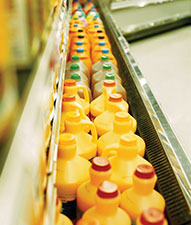The Basics About Acid Levels in Food
PROCESSING
 Acid is an important component of many foods, contributing to human safety as well as desirable flavor. The usual measure of acid level in a food is pH, defined as the negative logarithm of the concentration of hydrogen ions, expressed as gram equivalents per kilogram (essentially, molar concentration). A value of 7 indicates neutrality and is found for pure water. Lower values indicate acidity, and higher values than 7 indicate basicity. The scale runs from 0 to 14. Few foods have values much above 8.
Acid is an important component of many foods, contributing to human safety as well as desirable flavor. The usual measure of acid level in a food is pH, defined as the negative logarithm of the concentration of hydrogen ions, expressed as gram equivalents per kilogram (essentially, molar concentration). A value of 7 indicates neutrality and is found for pure water. Lower values indicate acidity, and higher values than 7 indicate basicity. The scale runs from 0 to 14. Few foods have values much above 8.
An important dividing value for food safety is pH of 4.6. Below pH 4.6, vegetative cells of Clostridium botulinum do not produce toxin, so foods with pH below 4.6 are considered high-acid foods and are safe from botulism. Unfortunately, there are other pathogens that may survive, at least for a little while in high-acid foods.
Low-acid foods are at risk for botulism and so must be protected by severe preservation processes, such as thermal canning, designed to kill heat-resistant spores of C. botulinum. (Spores are dormant forms of microbes that are highly resistant to extremes of temperature and other conditions that can kill vegetative or active cells.)
These considerations explain why new or well-established preservation processes must be evaluated in the context of a target food’s pH. High-acid foods, with pH below 4.6, are often pasteurized, meaning that vegetative pathogens are killed, but some spores and spoilage microbes may survive. Such foods are often refrigerated and have relatively short shelf lives because they can eventually spoil.
Low-acid foods require treatments adequate to kill C. botulinum spores and so are considered commercially sterile since a treatment that kills C. botulinum spores will kill nearly anything else. Commercially sterile foods are usually shelf-stable if they are properly packaged and protected from post-processing contamination, meaning they have extended shelf lives at ambient or room temperatures. Canning is a familiar and mature preservation process for low-acid foods and is governed by Food and Drug Administration (FDA) regulations, known as Low Acid Canned Foods regulations.
These require detailed filing with FDA of the exact process and container description and then careful process control by properly trained operators and management.
Alternate processes for low-acid foods must demonstrate effectiveness equivalent to properly performed thermal canning. Examples include irradiation, pressure-assisted thermal sterilization (PATS), low-acid aseptic processing, and microwave sterilization. In general, the standard for low-acid foods is a 12 log reduction in C. botulinum spores. By comparison, FDA requires a 5 log reduction in target organisms for almost all other types of preservation processes. The rationale has traditionally been that botulism is so hazardous and the risk is very high, whereas most other pathogens are somewhat less severe and risks are somewhat mitigated by other measures, such as low pH.
--- PAGE BREAK ---
What Are the Acids in Foods?
Foods may have low pH because of indigenous acids or added acids. Most fruits and fermented foods have enough edible acids that their pH is well below 4.6. Examples include citric acid in citrus fruits, malic acid in apples, and lactic acid in cheese, pickles, sauerkraut, and dried sausage. Any food whose natural pH is below 4.6 is considered an acid food. Under the FDA regulations, such foods and products derived predominantly from them do not require that their processes be filed with FDA. Naturally acid juices are still governed by juice Hazard Analysis Critical Control Points (HACCP) regulations, meaning they must have HACCP plans that conform to FDA expectations. Compliance with such requirements essentially complies with Food Safety Modernization Act requirements.
 Foods that achieve a low pH value by the addition of edible acids or acid foods to low-acid foods are considered acidified foods and must have processes filed with the FDA. Process filings must rely on a process authority, who may be an employee or a third party. Process authorities must be knowledgeable in the area, but are otherwise self-declared. Many belong to a small professional society, the Institute for Thermal Processing Specialists, whose name is misleading since many members are expert in acidified foods and aseptic processing as well as thermal processing.
Foods that achieve a low pH value by the addition of edible acids or acid foods to low-acid foods are considered acidified foods and must have processes filed with the FDA. Process filings must rely on a process authority, who may be an employee or a third party. Process authorities must be knowledgeable in the area, but are otherwise self-declared. Many belong to a small professional society, the Institute for Thermal Processing Specialists, whose name is misleading since many members are expert in acidified foods and aseptic processing as well as thermal processing.
A common way to acidify foods is to add vinegar, whose active acid is acetic. In addition to lowering pH, there is good evidence that acetic acid is antimicrobial as well. Foods with pH below about 3.3, and, for some, below 3.8, due to added acetic acid, kill otherwise acid-resistant pathogens in a matter of hours. The kill rate is slightly dependent on temperature for some tested foods, proceeding more quickly at warmer temperatures. Spoilage can also proceed more rapidly at warm temperatures, so there can be a trade-off in a cold fill and hold process. The optimum seems to be “cool ambient,” which is a little below 70°F or so.
Cold fill and hold refers to an accepted preservation process for acidified foods in which the pH is adjusted to a target value, often determined by organoleptic considerations, allowed to equilibrate by holding at a cool ambient temperature, testing for pH after at least 24 hr and then releasing. This process may be compared to thermal pasteurization, which is often undesirable or impractical. Many foods are altered unfavorably by heating. If they are heated before filling and filled hot, called hot fill and hold, the container must be capable of resisting the heat. After filling, the hot container must be cooled. If it is large, cooling may take a long time, resulting in more flavor damage.
Heating containers after filling can be done if the container is small enough to be heated and cooled reasonably quickly and if the container is resistant to heat. Small containers of plastic strong enough for hot fill or post-filling pasteurization can be expensive. Metal and glass containers have traditionally been used in such service, but they can be heavy and less well accepted compared to plastic containers.
Large containers, as are used for industrial ingredients, such as juices and purees, are often fiber drums with plastic liners. These do not lend themselves to any of the conventional thermal processing approaches but are often appropriate for cold fill and hold because of their pH and, possibly, other preservatives. Many approved chemical preservatives are organic acids or their salts, such as sorbic, propionic, and benzoic acids. These are most effective in low pH foods because it is the undissociated organic acid that is capable of penetrating microbial cells. When used as salts, the acid reforms in the low pH environment. The salts are more soluble than the acid forms.
--- PAGE BREAK ---
Aseptic Packaging
Aseptic processing and packaging refers to sterilizing a fluid food and its container separately then bringing them together in a sterile environment. The pH of the food determines how severe a thermal process the food needs to receive. The package may be sterilized a different way, depending on its size and material. The familiar paperboard laminate juice box is sterilized as a flat roll of the material using hydrogen peroxide, then the box is formed online, filled, and sealed.
Thermoformed trays or capsules are formed from sheets of plastic by heating to soften, then pressing into shape. The heat sterilizes the container. Blow-molded bottles are sterilized with peracetic acid and then rinsed with sterile water.
Larger containers, such as plastic bags up to 300 gal are sterilized by irradiation and filled in a sterile atmosphere after puncturing a sterile seal. Aseptic tanks holding up to 1 million gal are sterilized by filling with a dilute solution of a sterilant that does not require rinsing. (That development, among others, earned Phil Nelson of Purdue University the World Food Prize a few years ago.)
No matter what process is used for high- or low-acid foods, post-processing contamination can be a risk. In canning, because the package is under vacuum, there is a chance for contaminated cooling water to be sucked into the can through damaged seams or side welds (in three-piece cans). That is why chlorinating cooling water is often a critical control point in low-acid canning processes.
Every type of package has a potential vulnerability: plastic pouches are easily punctured; any container with a closure (cap or lid) may have a faulty seal; cans can suffer corrosion. Consequently, food processing and packaging must be evaluated as a complete system, including subsequent handling.
High-acid and acidified foods offer an additional line of defense in that they are inherently hostile environments to microbes. Because of their low pH and the antimicrobial activity of some acids, acidified foods are largely self-protecting. Further, they can sterilize packaging materials with which they come in contact, so less-expensive packages can be used with confidence. As new products are developed, such as functional beverages, it can be helpful to formulate with as low a pH as good organoleptic acceptance allows. This can minimize the severity of potential preservation processes and possibly allow use of thermally sensitive proteins.
 J. Peter Clark, Ph.D., CFS,
J. Peter Clark, Ph.D., CFS,
Contributing Editor,
Consultant to the Process
Industries, Oak Park, Ill.
[email protected]
